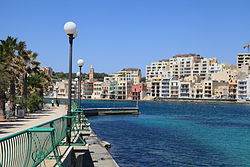Marsaskala
|
Marsaskala Wied il-Għajn Marsascala, M'Skala |
|||
|---|---|---|---|
| Local council | |||

Marsaskala Bay
|
|||
|
|||
| Motto: Għajn ta' kenn u mistrieħ | |||
 |
|||
| Coordinates: 35°51′45″N 14°34′3″E / 35.86250°N 14.56750°ECoordinates: 35°51′45″N 14°34′3″E / 35.86250°N 14.56750°E | |||
| Country |
|
||
| Region | South Eastern Region | ||
| District | South Eastern District | ||
| Borders | Marsaxlokk, Żabbar, Żejtun | ||
| Government | |||
| • Mayor | Mario Calleja (PL) | ||
| Area | |||
| • Total | 5.4 km2 (2.1 sq mi) | ||
| Population (March 2014) | |||
| • Total | 12,134 | ||
| • Density | 2,200/km2 (5,800/sq mi) | ||
| Demonym(s) | Skalin | ||
| Time zone | CET (UTC+1) | ||
| • Summer (DST) | CEST (UTC+2) | ||
| Postal code | MSK | ||
| Dialing code | 356 | ||
| ISO 3166 code | MT-27 | ||
| Patron saint | St. Anne | ||
| Day of festa | Last Sunday of July | ||
| Website | Official website | ||
Marsaskala (M'Skala, Maltese: Wied il-Għajn), sometimes spelt Marsascala (M'Scala), is a sea-side village in the South Eastern Region of Malta that has grown around the small harbour at the head of Marsaskala Bay, a long narrow inlet also known as Marsaskala Creek. The bay is sheltered to the north by Ras iż-Żonqor, the south-east corner of Malta, and to the south by the headland of Ras il-Gżira.
The parish church is dedicated to Sant Anna (St. Anne) and St. Anne's feast is celebrated at the end of July in Marsaskala.
The town has a winter population of 12,134 people (as of March 2014), but swells to around 20,000 in summer.
Different opinions exist regarding the origin of the name Marsaskala. While it is commonly agreed that Marsa is an Arabic word meaning bay, Skala has given rise to different interpretations. It could have been derived from Sqalli (Sicilian) for Marsaskala was frequented by Sicilian fishermen since Malta is just 60 miles (97 km) south from Sicily. Maybe it was derived from the Sicilian 'Piccola Cala' meaning little inlet or it was just a reference to some rock-cut steps on the water's edge since scala also means a straight flight of steps.
Marsaskala is better known as Wied il-Għajn by the Maltese as the bay and the old small village are flanked by two valleys, through which a spring of fresh water used to flow down into the innermost bay. Wied means valley and Għajn (pronounced ayn) refers to the spring of fresh water. Literally, Wied il-Għajn means Valley of the Spring.
Man inhabited this area thousands of years ago as evidenced by the several archaeological remains found in various areas of Marsaskala. Its Pre-history is normally divided in the Neolithic period and the Bronze Age. Some of the most ancient remains at Marsaskala are undoubtedly the cart-ruts, which are parallel channels formed in the rock face. Some of Malta's cart-ruts, mysteriously, lead straight into the sea. Difficulties and uncertainties still abound as regards their use as well as the time and the way they were made, though it seems that they served to transport heavy burdens from one place to another.
Early Christian catacombs as well as Roman era villa remains, were also discovered in Marsaskala, the latter suggesting that Marsaskala was also a Roman port. Remains of Roman Baths were found in a field at il-Gżira, a rock peninsula behind the Jerma Palace Hotel.
...
Wikipedia


